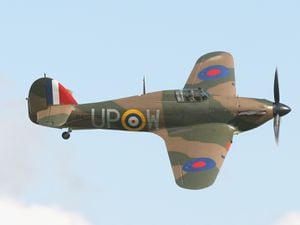Day a Shropshire fighter tried to shoot down 'suspicious' RAF bomber
Having noticed that he had been intercepted by a Hurricane fighter scrambled from RAF Shawbury, the pilot of the Wellington bomber went back to reading his map.

He was about to be rudely interrupted. Because what happened next was surely one of the most extraordinary incidents in the history of the Royal Air Force, with echoes of the dilemma faced by American fighter pilots had they successfully intercepted the hijacked airliners during the September 11 terror attacks.
The Hurricane pilot, Squadron Leader P H Maxwell, decided he was being wilfully ignored and that the RAF bomber had failed to show friendly intent. So, after firing warning shots without any response, he decided to shoot it down.
And it was only because he ran out of ammunition that tragedy was averted.

The incident happened during the war, on November 3, 1940, during the height of the Blitz, and was to lead to a court of inquiry.
Squadron Leader Maxwell was the chief flying instructor with 11 Service Flying Training School based at RAF Shawbury and, while the Shropshire airfield's role at the time was training in twin-engined Oxford aircraft, Maxwell was also in charge of the air base's fighter defence flight.
His actions that day, a Sunday, were influenced by his knowledge of a previous incident, on October 25, in which a Wellington bomber had been challenged by a fighter flown from another resident unit at Shawbury, 27 Maintenance Unit, but had taken no notice when the fighter fired across its bows.
Alerted by the Observer Corps at Shrewsbury of the approach of a Wellington bomber, Maxwell scrambled from the base and caught up with it at Sutton Coldfield. The situation rapidly deteriorated.
"I noticed there were no squadron markings," Squadron Leader Maxwell told the inquiry.

"I then flew in front and above and dived past several times expecting him either to slow down and drop his wheels, or to fire the colour of the day. He took neither of these precautions but just continued on course and speed. I then fired a burst across his nose. Having used one in five tracer he could not possibly have failed to notice. I repeated the burst. He ignored it. I now decided to bring him down if possible."
He opened fire directly on the bomber, making several passes, but ran out of ammunition and, in thick weather, lost him.
Unsurprisingly, the bomber pilot had a different perspective on events. He was Pilot Officer W E J Lewis, who was with a ferry pool at Hawarden airfield, near Chester – the job of ferry pilots was to fly planes to where they were needed, as obviously operational pilots had other things on their plate.
Lewis had been tasked with delivering the bomber from Hawarden to No 300 (Polish) Squadron at RAF Swinderby in Lincolnshire, but had become a bit lost in bad weather and was trying to follow landmarks through the murk. He had seen the Hurricane, but had initially thought little of it and continued map reading.
"I thought he was just having a look at me," he told the inquiry.
"Approximately 30 seconds later I heard an unusual sound, and looking up I saw tracer bullets passing over and to the left of the cabin."
A further attack was made from the starboard quarter, and a third from dead astern.
Whether the plane was actually hit is not specifically made clear in the inquiry records. In any event Lewis had problems lowering the undercarriage and the flaps were not working.
"I eventually landed at Swinderby at 1300 hours and handed the Wellington over to the consignee," he said.
"In landing without flaps the tail wheel apparently snapped off and the rear turret was further damaged by dragging along the aerodrome surface."
Lewis was questioned by the inquiry officers about why he had not fired off the recognition colours of the day, but it turned out that the Verey pistol was not within his reach and in any event he did not take any cartridges for it.
In its findings the inquiry said that Squadron Leader Maxwell should have done more to find out if the bomber was friendly before opening fire, and that while Pilot Officer Lewis was negligent in not having had a Verey pistol with cartridges immediately available, he did make an effort to give the recognised signal of friendly intentions by lowering the undercarriage, but it was thwarted by a partial failure of the mechanism.
The court of inquiry was reassembled at RAF Shawbury a little later to take further evidence relating to procedures, but it seems the kerfuffle blew over, being overtaken by events, as it reported: "In view of the fact that the security flight at Shawbury no longer exists, the Court has no further recommendations to make. It is of interest to note that the security flight is no longer considered necessary as there is now a fighter squadron stationed at RAF Station, Tern Hill."
